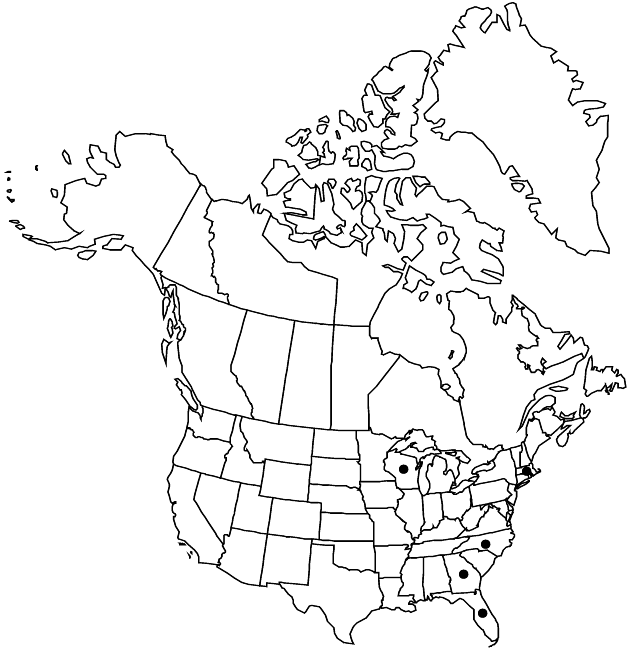Difference between revisions of "Crepis foetida"
Sp. Pl. 2: 807. 1753.
FNA>Volume Importer |
imported>Volume Importer |
||
| (6 intermediate revisions by 2 users not shown) | |||
| Line 8: | Line 8: | ||
}} | }} | ||
|common_names=Stinking or roadside hawksbeard | |common_names=Stinking or roadside hawksbeard | ||
| + | |special_status={{Treatment/ID/Special_status | ||
| + | |code=I | ||
| + | |label=Introduced | ||
| + | }} | ||
|basionyms= | |basionyms= | ||
|synonyms= | |synonyms= | ||
| Line 24: | Line 28: | ||
|elevation=80–1200 m | |elevation=80–1200 m | ||
|distribution=Fla.;Ga.;Mass.;N.C.;Wis.;Eurasia. | |distribution=Fla.;Ga.;Mass.;N.C.;Wis.;Eurasia. | ||
| − | |discussion=<p>Crepis foetida is polymorphic; it is recognized by its annual or biennial habit, usually erect and hispid or setose stems, sharply runcinate leaves, hispid or setose involucres, and dimorphic cypselae.</p> | + | |introduced=true |
| + | |discussion=<p><i>Crepis foetida</i> is polymorphic; it is recognized by its annual or biennial habit, usually erect and hispid or setose stems, sharply runcinate leaves, hispid or setose involucres, and dimorphic cypselae.</p> | ||
|tables= | |tables= | ||
|references= | |references= | ||
| Line 33: | Line 38: | ||
-->{{#Taxon: | -->{{#Taxon: | ||
name=Crepis foetida | name=Crepis foetida | ||
| − | |||
|authority=Linnaeus | |authority=Linnaeus | ||
|rank=species | |rank=species | ||
| Line 48: | Line 52: | ||
|publication title=Sp. Pl. | |publication title=Sp. Pl. | ||
|publication year=1753 | |publication year=1753 | ||
| − | |special status= | + | |special status=Introduced |
| − | |source xml=https:// | + | |source xml=https://bitbucket.org/aafc-mbb/fna-data-curation/src/2e0870ddd59836b60bcf96646a41e87ea5a5943a/coarse_grained_fna_xml/V19-20-21/V19_286.xml |
|tribe=Asteraceae tribe Cichorieae | |tribe=Asteraceae tribe Cichorieae | ||
|genus=Crepis | |genus=Crepis | ||
Latest revision as of 19:50, 5 November 2020
Annual, biennials, or perennials, 10–50 cm (roots fibrous, shallow). Stems 1(–3+), erect to decumbent or prostrate, branched proximally or distally, hispid and/or setose. Leaves basal and cauline; petiolate; blades oblanceolate, runcinate, 3–13 × 1–3 cm, margins denticulate to pinnately lobed (lobes deltate to lanceolate, often sharply serrate, terminal relatively large), apices acute, faces hispid to villous (cauline sessile, blades ovate to lanceolate or linear, runcinate, bases auriculate, margins deeply pinnately lobed, lobes linear). Heads 3–10+, in cymiform arrays. Calyculi of 8–10, linear to lanceolate, densely hispid bractlets 2–5 mm (becoming lax). Involucres cylindric to turbinate, 7–16 × 4–13 mm. Phyllaries 8–12, lanceolate (bases strongly keeled, enclosing marginal cypselae, margins green), apices acute to attenuate, abaxial faces hispid or setose, adaxial with fine hairs. Florets 80–100+; corollas yellow (usually reddish purple adaxially), 9–16 mm. Cypselae (dimorphic) subcylindric, outer stout, 7–9 mm, nearly beakless, inner 12–17 mm, beaks 2–5 mm; pappi dull white, 3–7 mm. 2n = 10.
Phenology: Flowering Apr–Sep.
Habitat: Seashores, plains, hills, and mountains
Elevation: 80–1200 m
Distribution

Introduced; Fla., Ga., Mass., N.C., Wis., Eurasia.
Discussion
Crepis foetida is polymorphic; it is recognized by its annual or biennial habit, usually erect and hispid or setose stems, sharply runcinate leaves, hispid or setose involucres, and dimorphic cypselae.
Selected References
None.